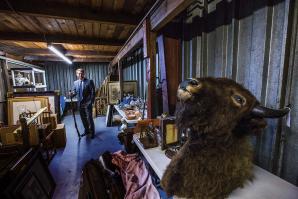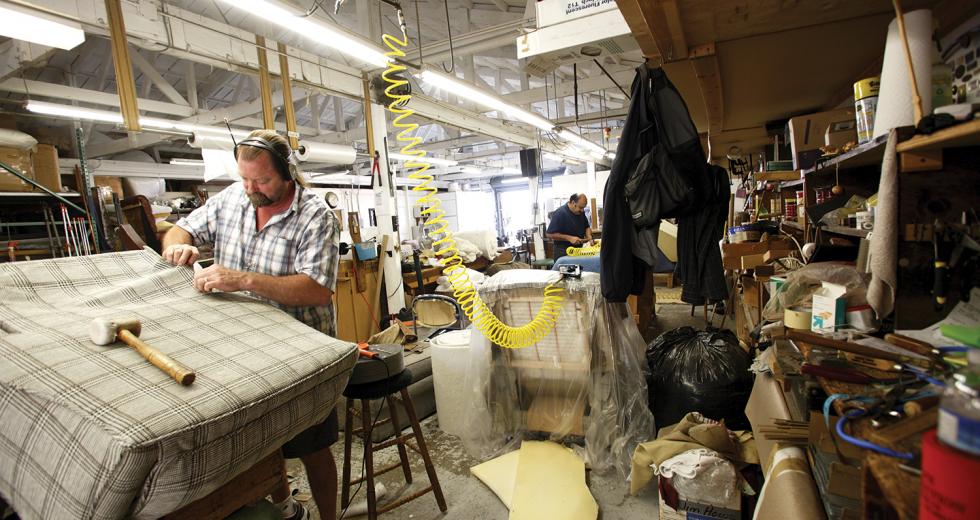When Sacramento-based Breuner’s furniture store chain closed its in-house upholstery shop in 1971, the eight seamstresses and upholsterers were told that, if they opened their own shop, Breuner’s would send its work their way.
Before long, Allied Custom Upholsterers was in business inside a modest, 5,000-square-foot rental off Del Paso Boulevard, where it remains today.
The partners agreed that upon retirement, they’d sell their stake in Allied to any of the original eight still working. Wally Baker, lead upholsterer by day and car racer by night, was the youngest of the bunch and became Allied’s sole owner 20 years ago.
“Right after I got out of the service in 1946, my mother kept yapping at me to get a job,” he says. “I had been helping at my uncle’s auto shop before, but I didn’t want to get my hands dirty. So I took a job as an (upholstery) apprentice at Breuner’s for $65 a month.”
Baker is now 83 and retired, but Allied Upholstery remains in the family, run by his daughter Lauri Baker Kirk, 50, who started working there at 18.
“I went to college and got a teaching degree,” Kirk says, “but I loved it here. Everyone is so excited when they’re going to upholster a piece. It’s a wonderful process. I believe with all my heart that we’re going to take your sofa [or] your chair and make it beautiful. And you’re going to be happy. My job is easy because of these people.”
Helping out in the front office, which houses thousands of fabric samples, are her 82-year-old mother (Wally’s wife), Connie Baker; and 24-year-old daughter Kaitlyn Kirk, who recently earned a degree in biomedical engineering.
The shop employs two seamstresses and seven upholsterers, each with a particular role. Antonio Garcia, for instance, is the cushion stuffer. Ramberto Valenzuela cuts the new fabric, and Severiano Villa strips old fabric from the frame. Theresa Ledford, head seamstress and shop supervisor, is married to Greg Ledford, an “outsider.” He applies the fabric, attaches trim, taps in finishing nails and adds the skirts.
“A lot of upholstery shops give a guy a job, and it’s his,” says Lauri Kirk. “He cuts, reupholsters and he’s done. We don’t do that. We work as a team, and we very much encourage them to take their time. I don’t keep track of how many hours they have on a job. It may be a detriment from a business standpoint, but I feel like they would rush if they were paid by the job.
“It’s a very artistic process, how they pull the fabric and pad. You not only have to have training but an artistic ability to do this job well. I think if we started timing everyone, we would lose something in the process,” she says.
The work is still being done much the same as it was 40 years ago when Allied began. Springs are hand-tied with cotton jute and carefully leveled for seating comfort. Fabric is cut thoughtfully to take advantage of the patterns. The workers might consider whether to center a cabbage rose on a cushion or whether the thorny vine should go this way or that.
The major difference between then and now is the steady rat-a-tat-tat rhythm of electric staple guns. Back in Wally Baker’s day, they used tack hammers. “We’d have a mouthful of tacks and take them out one at a time, and the hammer had a magnet on the end,” he says. “Everything else is about the same.”
But, his daughter says, staples do less damage to the wood frames, which is important for furniture being reupholstered again and again. They occasionally see pieces back for new fabric 25 years later.
Allied charges a flat rate for labor: $1,250 for a seven-foot sofa, and $545 for a chair. On top of that is the price of fabric (which costs $25 to $200 a yard), cushions, skirts, buttons, and pickup and delivery.
The craftsmen stay busy, particularly in November and December when clients want new looks for the holidays. However, Allied’s profits have declined steadily over the past five years. Total income in 2010 was down nearly $300,000 from 2006.
“The price of new furniture is so cheap that I feel like we’re a dying art,” Kirk says. “When my dad first started, they did tons of upholstery for the middle-income, and I feel now that it’s become something that has to be a really special piece to the person or we’re working with a higher-end client because it is expensive.”
Allied has never advertised because that would mean competing against the interior designers and furniture stores that bring them work.
Sacramento designer Gary Johns of Gary Johns & Associates took his first piece of client furniture to Allied 37 years ago. “We’ve had different drapery and carpeting and painters, but Allied is the only upholsterer we’ve used consistently. It’s because of the quality of work they do.”
Marylou Colombo, who owns the Gold River design firm Disegno, has taken residential and commercial work to Allied for 20 years. “You don’t find that many upholsterers anymore, and if you do, the quality is not like Allied’s. They take an old-fashioned approach, and I appreciate that. It’s a wonderful family business.”
The bustling workroom is filled with furniture waiting to be upholstered, including platform seating for a marijuana dispensary in Stockton, and the craftsmen work six days a week to complete year-end jobs. But nobody is getting rich.
“We do whatever it takes to get the job done to the best of our ability,” says Kirk. “I can’t say we’re making a profit, but if we can keep everyone working and clients happy, I’m thrilled.”
Recommended For You

Pricing the Past
Collector Brian Witherell on the gambles and gains of antiques
Juxtaposed against the crisp, modern lines of Brian Witherell’s home in Alkali Flat sits a trove of ancient treasures, premier antiquities cherry picked from his company’s massive antique collection.

Family Advocate
A new family-business crusader emerges
California’s seven family business centers (including two in the Capital Region) are committed to addressing the needs and challenges of family-owned companies.
However, all are registered as 501(c)3 organizations, and as such are precluded from lobbying activities.



